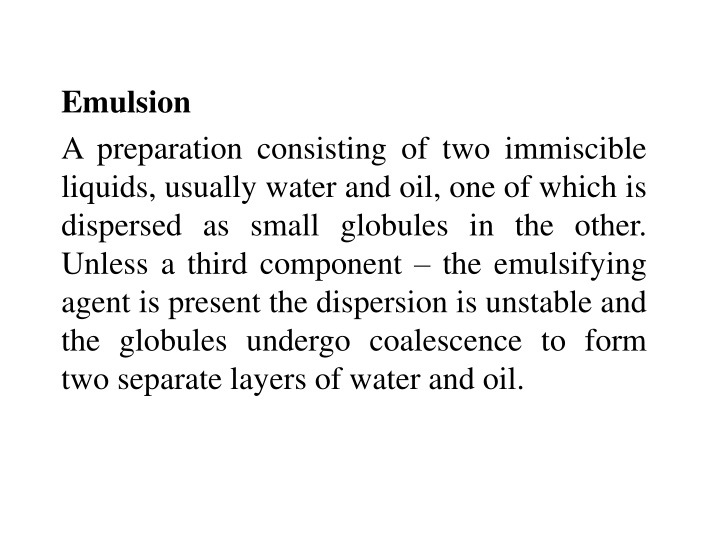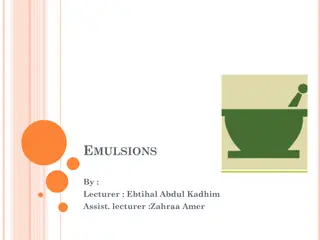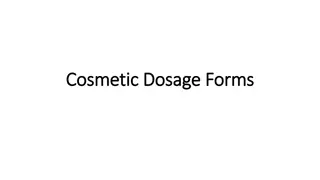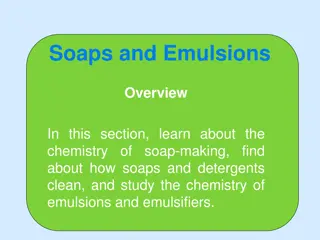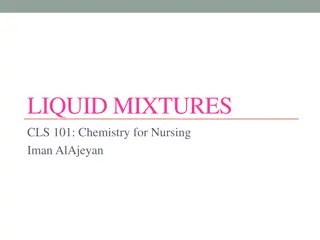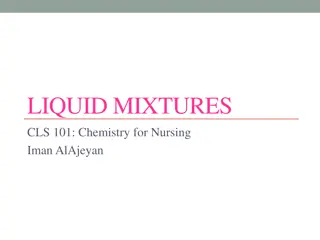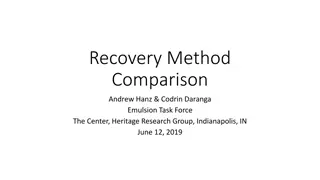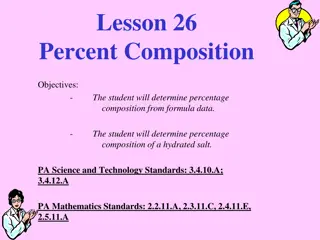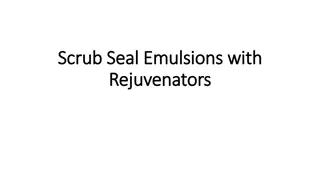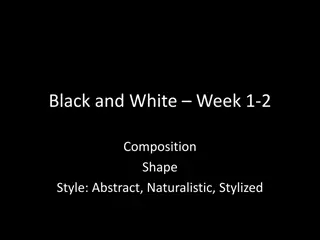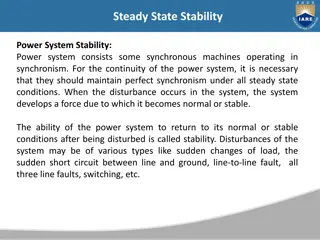Emulsions: Types, Composition, and Stability
Emulsions are preparations of two immiscible liquids, such as water and oil, stabilized by an emulsifying agent. The composition of emulsions includes aqueous and oil phases, each with specific considerations for stability and effectiveness. Types of emulsions include oil-in-water and water-in-oil emulsions, each with distinct properties and applications in cosmetics and pharmaceuticals.
Download Presentation

Please find below an Image/Link to download the presentation.
The content on the website is provided AS IS for your information and personal use only. It may not be sold, licensed, or shared on other websites without obtaining consent from the author.If you encounter any issues during the download, it is possible that the publisher has removed the file from their server.
You are allowed to download the files provided on this website for personal or commercial use, subject to the condition that they are used lawfully. All files are the property of their respective owners.
The content on the website is provided AS IS for your information and personal use only. It may not be sold, licensed, or shared on other websites without obtaining consent from the author.
E N D
Presentation Transcript
Emulsion A preparation consisting of two immiscible liquids, usually water and oil, one of which is dispersed as small globules in the other. Unless a third component the emulsifying agent is present the dispersion is unstable and the globules undergo coalescence to form two separate layers of water and oil.
The aqueous phase may consist of water soluble drugs, preservatives coloring and flavoring agents. It is desirable to use distill or deionized water, since calcium and magnesium ions found in hard water can have an adverse effect on the stability of some emulsions, containing fatty acid soaps as the emulsifying agents particularly those
The oil phase of an emulsion frequently consist of fixed or volatile oils and drugs that exist as oils, such as oil soluble vitamins and antiseptics. It is frequently necessary to add an antioxidant to prevent autoxidation of the oil and consequent distraction of any vitamin present. Oils used in the preparation of emulsion should also be kept free of microorganisms, since these too can cause rancidity. rancidity and /or
The emulsifying agent is the most important component of the emulsion in terms of achieving stability. synthetic emulsifying agents are used in their preparation. Both natural and
Types of emulsion Oil in water emulsion If the oil droplets are dispersed throughout the aqueous phase, the emulsion is termed oil-in- water (O/W). They are non greasy and are easily removable from the skin surface and they are used externally to provide internally to mask the bitter taste of oil. O/W emulsion give a positive conductivity test as water, the external phase is a good conductor of electricity cooling effect and
Water in oil emulsion A system in which water is dispersed as globules in the oil is termed water-in-oil emulsion (W/O). They are greasy and not water washable and are used externally to prevent evaporation of the moisture from the surface of skin e.g. cold cream. They are preferred for formulation meant for external use like cream.
W/O conductivity tests, because oil is the external phase which is a poor conductor of electricity. Multiple emulsions Multiple emulsions are complex systems. They can be considered as emulsions of emulsions. It is a complex type of emulsion system in which the oil-in-water emulsions are dispersed in another liquid medium. emulsion do not give a positive or water-in-oil
For example small water droplets can be enclosed within larger oil droplets, which are themselves then dispersed in water. This gives a water-in-oil-in-water (w/o/w) emulsion. The alternative o/w/o emulsion is also possible. Their pharmaceutical taste masking. Multiple emulsions have been formulated as cosmetics, such as skin moisturizer. Prolonged release can also be obtained by means of multiple emulsions. applications include
These systems have some advantages, such as the protection of the ensnared (trapped) substances and the incorporating several actives ingredient in the different compartments. Regardless of their importance, multiple emulsions have limitations because instability and their complex structure. possibilities of thermodynamic of
Microemulsion Unlike the coarse emulsions, microemulsions are homogeneous, transparent systems that are thermodynamically stable. Moreover, they form spontaneously components are mixed in the appropriate ratios. They can be dispersions of oil in water or water in oil, but the droplet size is very much smaller 5-140 nm than in coarse emulsion 5000Aor 500 nm. when the
An essential requirement for their formation and stability is the attainment of a very low interfacial tension. It is generally not possible to achieve the required lowering of interfacial tension with a single surfactant, and it is necessary to include a second amphiphile, usually a medium chain length alcohol, in the formulation. The second amphiphile is referred to as the cosurfactant.
Although microemulsions have many advantages over coarse emulsions, transparency and stability, they require much larger amounts of formulation, which restricts acceptable components. particularly their surfactant for choice their the of
Detection of emulsion Dilution test The dilution method depends on the fact that an O/W emulsion can be diluted with water and a W/O emulsion with oil. When oil is added to an O/W emulsion or water to a W/O emulsion, the incorporated into the emulsion and separation is apparent. additive is not
Conductivity test An emulsion in which the continuous phase is aqueous can be expected to possess a much higher conductivity than an emulsion in which the continuous phase is an oil. Accordingly, it frequently happens that when a pair of electrodes, connected to a lamp and an electrical source, are dipped into an O/W emulsion, the lamp lights because of the passage of a current between the two electrodes. If the lamp does not light, it is assumed that the system is W/O.
Dye-solubility test The incorporation of an oil-soluble dye to an emulsion will show: Colored globules on a colorless background if the emulsion is oil-in-water type; and colorless globules against a colored background if the emulsion is water-in-oil type.
Theories of emulsification Many theories have been advanced in an attempt to explain how emulsifying agents promote emulsification and maintain the stability of the emulsion. Among the most prevalent theories are the surface tension theory, theory, and the plastic or interfacial film theory. the oriented-wedge
Surface tension theory All liquids have a tendency to assume a shape having the minimal surface area exposed. For a drop of a liquid, that shape is the sphere. A liquid drop has the shape of a sphere. It possesses internal forces that tend to promote association of the molecules to resist distortion of the sphere.
If two or more drops of the same liquid come into contact with one another, the tendency is for them to join or to coalesce, making one larger drop having a smaller surface area than the total surface area of the individual drops.
When the surrounding of the liquid is air, it is referred to as the liquid s surface tension. When the liquid is in contact with a second liquid in which it is insoluble and immiscible, the force causing each liquid to resist breaking up into smaller particles is called interfacial tension. Substances that reduce this resistance encourage a liquid to break up into smaller drops or particles. These tension-lowering substances are surface-active (surfactant) or wetting agents.
According to the surface tension theory of emulsification, the use of these substances as emulsifiers and stabilizers lowers the interfacial tension of the two immiscible liquids, reducing the repellent force between the liquids and diminishing each liquid s attraction for its own molecules. Thus, the surface active agents facilitate the breaking up of large globules into smaller ones, which then have a lesser tendency to reunite or coalesce.
Oriented-wedge theory The oriented-wedge monomolecular layers of emulsifying agent curved around a droplet of the internal phase of the emulsion. The theory is based on the presumption that certain emulsifying agents orient themselves about and within a liquid in a manner reflective of their solubility in that particular liquid. theory assumes
In a system containing two immiscible liquids, presumably the emulsifying preferentially soluble in one of the phases and is embedded more deeply and tenaciously in that phase than the other. agent is
Because many molecules of substances upon which this theory is based (e.g., soaps) have a hydrophilic or water-loving portion and a hydrophobic or water-hating portion (but usually lipophilic or oil loving), the molecules position or orient themselves into each phase. Depending on the shape and size of the molecules, their solubility characteristics, orientation, the wedge shape envisioned for the molecules causes either oil globules or water globules to be surrounded. and thus their
Generally, an emulsifying agent having a greater hydrophilic than hydrophobic character will promote an o/w emulsion, and a w/o emulsion results from use of an emulsifying agent that is more hydrophobic than hydrophilic. The phase in which the emulsifying agent is more soluble will become the continuous or external phase of the emulsion.
Plastic or interfacial film theory The plastic or interfacial film theory places the emulsifying agent at the interface between the oil and water, surrounding the droplets of the internal phase as a thin layer of film adsorbed on the surface of the drops. The film prevents contact and coalescing of the dispersed phase; the tougher and more pliable the film, the greater the stability of the emulsion.
Naturally, enough of the film forming material must be available to coat the entire surface of each drop of the internal phase. Here again, the formation of an o/w or a w/o emulsion depends on the degree of solubility of the agent in the two phases, with water-soluble agents encouraging o/w emulsions and oil-soluble emulsifiers the reverse.
Emulsifying agents Emulsifying accordance with the type of film they form at the interface between the two phases. agents may be classified in
Monomolecular films Those surface-active agents that are capable of stabilizing an emulsion by forming a monolayer of adsorbed molecules or ions at the oil water interface. These agents results in a reduction in interfacial tension which results in a more stable emulsion. This reduction is probably not the main factor promoting stability. More significant is the fact that the droplets are surrounded now by a coherent monolayer that prevents coalescence between approaching droplets.
If the emulsifier forming the monolayer is ionized, the presence of strongly charged and mutually repelling droplets increases the stability of the system. With un-ionized, nonionic surface active agents, the particles may still carry a charge; this arises from adsorption of a specific ion or ions from solution.
Multimolecular films Hydrated proteins etc.) form multimolecular films around droplets of dispersed oil. The use of these agents has declined in recent years because of the large number of synthetic available that possess well-marked emulsifying properties. Although these hydrophilic colloids are adsorbed at an interface, they do not cause an appreciable lowering in surface tension. lyophilic colloids (gum, gelatin, surface-active agents
Rather, their efficiency depends on their ability to form strong coherent multimolecular films. These act as a coating around the droplets and render them highly resistant to coalescence, even in the absence of a well developed surface potential. Furthermore, any hydrocolloid not adsorbed at the interface increases the viscosity of the continuous aqueous phase; emulsion stability. this enhances
Solid particle films Small solid particles that are wetted to some degree by both aqueous and nonaqueous liquid phases act as emulsifying agents. If the particles are too hydrophilic, they remain in the aqueous phase; if too hydrophobic, they are dispersed completely in the oil requirement is that the particles are small in relation to the droplets of the dispersed phase. phase. A second
Chemical Types Emulsifying agents also may be classified in terms of their chemical structure; there is some correlation between this classification and that based on the mechanism of action. For example, the majority of monomolecular films are synthetic, organic materials. Most of the emulsifiers that form multimolecular films are obtained from natural sources and are organic. emulsifiers forming
A third group is composed of solid particles, invariably inorganic, that form films composed of finely divided solid particles. Accordingly, the classification, adopted divides agents into synthetic, natural, and finely dispersed solids. A fourth group, the auxiliary materials are weak emulsifiers. emulsifying
Synthetic emulsifying agents Synthetic emulsifying agents may be subdivided into anionic, cationic, and nonionic, depending on the charge possessed by the surfactant.
Anionics In the anionic subgroup, the surfactant ion bears a negative charge. The potassium, sodium, and ammonium salts of lauric and oleic acid are soluble in water and are good O/W emulsifying agents. They do, however, have a disagreeable taste and are irritating to the gastrointestinal (GI) tract; this limits them to emulsions prepared for external use.
Solutions of alkali soaps have a high pH; they start to precipitate out of solution below pH 10 because the un- ionized fatty acid is now formed, and this has a low aqueous solubility. Further, the free fatty acid is ineffective as an emulsifier, so emulsions formed from alkali soaps are not stable at pH values less than about 10. The calcium, magnesium, and aluminum salts of fatty acids, often termed the metallic soaps, are water insoluble and result in W/O emulsions.
Another class of soaps are salts formed from a fatty acid and an organic amine such as triethanolamine. These O/W emulsifiers also are limited to external preparations, but their alkalinity is considerably less than that of the alkali soaps and they are active as emulsifiers down to around pH 8. These agents are less irritating than the alkali soaps.
Sulfated alcohols An example is sodium lauryl sulphate, which is widely used to produce o/w emulsions. These compounds are an important group of pharmaceutical surfactants. chiefly as wetting agents, although they do have some value as emulsifiers, particularly when used in conjunction with an auxiliary agent. They are used
Sulfonates Sulphonated compounds are much less widely used as emulgents. Materials of this class include sodium dioctylsulphosuccinate, and are more often used as wetting agents or for their detergency.
Cationics The surface activity in the cationic group resides in the positively charged compounds have properties. This makes them desirable in emulsified anti-infective products such as skin lotions and creams. The pH of an emulsion prepared with a cationic emulsifier lies in the pH 4 to 6 ranges. Because this includes the normal pH of the skin, cationic advantageous in this regard also. cation. bactericidal These marked emulsifiers are
Cationic agents are weak emulsifiers and generally are formulated with a stabilizing or auxiliary emulsifying agent such as cetostearyl alcohol. The only group of cationic agents used extensively as emulsifying quaternary ammonium example is cetyltrimethyl-ammonium bromide. agents compounds. are the An
Cationic emulsifiers should not be used in the same formulation with because they will interact. The incompatibility may not be immediately precipitate, but virtually all of the desired antibacterial activity will generally have been lost. anionic emulsifiers apparent as a
Nonionics Nonionics, widespread use as emulsifying agents when they possess the proper balance of hydrophilic and lipophilic groups within the molecule. Their popularity is based on the fact that, unlike the anionic and cationic types, nonionic emulsifiers are not susceptible to pH changes and the presence of electrolytes. undissociated surfactants, find
The most frequently used nonionic agents are the glyceryl esters, polyoxyethylene glycol esters and ethers, and the sorbitan fatty acid esters and their polyoxyethylene derivatives. In general, for nonionic emulsifiers, emulsion stability is best when blends of emulsifiers are used.
Natural emulsifying agents Natural emulsifying agents are derived from natural (i.e., plant and animal) sources. Acacia is a carbohydrate gum that is soluble in water and forms O/W emulsions. Emulsions prepared with acacia are stable over a wide pH range. Because it is a carbohydrate it is necessary to preserve acacia emulsions against microbial attack by the use of a suitable preservative.
Gelatin, a protein, has been used for many years as an emulsifying agent. Gelatin can have two isoelectric points, depending on the method of preparation. So-called Type A gelatin, derived from an acid-treated precursor, has an isoelectric point of between pH 7 and 9.
Type B gelatin, obtained from an alkali treated precursor, has an approximately pH 5. Type A gelatin acts best as an emulsifier around pH 3, where it is positively charged; on the other hand, Type B gelatin is best used around pH 8, where it is negatively charged. isoelectric point of
To avoid an incompatibility, all emulsifying agents should carry the same sign. Thus, if gums (such as tragacanth, acacia, or agar) that are negatively charged are to be used with gelatin, then Type B material should be used at an alkaline pH. Under these conditions the gelatin is similarly negatively charged.
